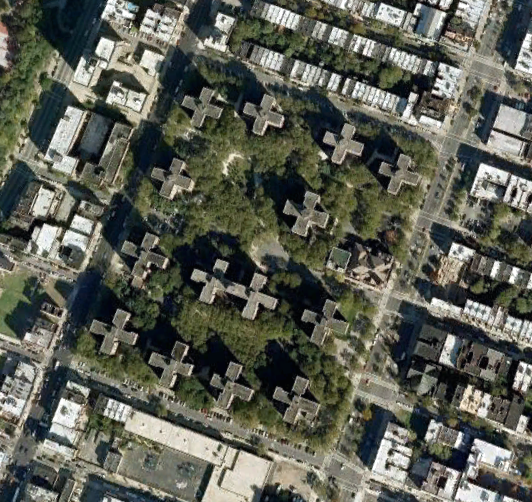RPA Panel: Walkable Urbanism Key to NYC’s Housing Policy
 NYCHA plans to restore 129th Street at St. Nicholas Houses (which would chop this superblock across the middle), part of an effort to integrate good neighborhood design with housing policy. Image: Google Earth.
NYCHA plans to restore 129th Street at St. Nicholas Houses (which would chop this superblock across the middle), part of an effort to integrate good neighborhood design with housing policy. Image: Google Earth.The key to building better and more affordable housing in New York City is that oft-cited but elusive quality: urbanism. So said a panel of housing policy experts and real estate developers at Friday’s RPA regional assembly.
New York City housing policy must create conditions for greater density, more walkability, and better planning throughout the city, the panelists agreed. Otherwise it will be impossible to achieve the PlaNYC goal of building homes for a million new New Yorkers by 2030 while making housing more affordable and ecologically sustainable.
Jerilyn Perine, the executive director of the Citizens Housing and Planning Council and the Department of Housing Preservation and Development Commissioner under Mayor Giuliani and Mayor Bloomberg, forcefully argued that a lack of proper planning has stood in the way of necessary efforts to build housing that enhances the city’s urban fabric. "Density — that’s what our city is about," she said, but added that "we have a love-hate thing with it. We don’t want it because we just do density but don’t do planning." She pointed to the Williamsburg waterfront as a location where large-scale development should be a boon to the city but isn’t being supplemented with necessary public services and transit investments, a pattern that Streetsblog examined at the parking-heavy New Domino development.
The panelists didn’t discuss the effect of New York City’s parking policy on housing affordability and urban design. But the qualities they praised conflict with policies that favor the construction of parking and induce more traffic, which disrupts the pedestrian environment and slows down buses. And they implicitly argued that effective transit is what keeps housing costs within reach for many New Yorkers. Every panelist agreed that no housing is affordable if you can’t get to a job from there.
Jonathan Rose, a developer who specializes in what he calls "green urban" projects, said that building walkable neighborhoods is critical to efforts to solve New York’s housing problems. "Safe and attractive streets" and "re-densifying" our cities are a prerequisite for good growth, he said.
One agency that’s doing some interesting work to connect housing policy with urban design is the New York City Housing Authority. NYCHA General Manager Mike Kelly pointed to a site where enhancing walkability is also helping to add and improve housing. At the St. Nicholas Houses in Harlem, NYCHA plans to restore the street grid to a towers-in-the-park superblock, extending 129th Street from Frederick Douglass Boulevard to Adam Clayton Powell, Jr. Boulevard.
The new street will make walking more convenient for residents and will be accompanied by the construction of a new charter school, operated by the Harlem Children’s Zone, and possibly new housing. It’s one example of the overlapping goals of affordable housing and good urbanism, and hints at the potential of a closer alliance between housing and livable streets advocates.





